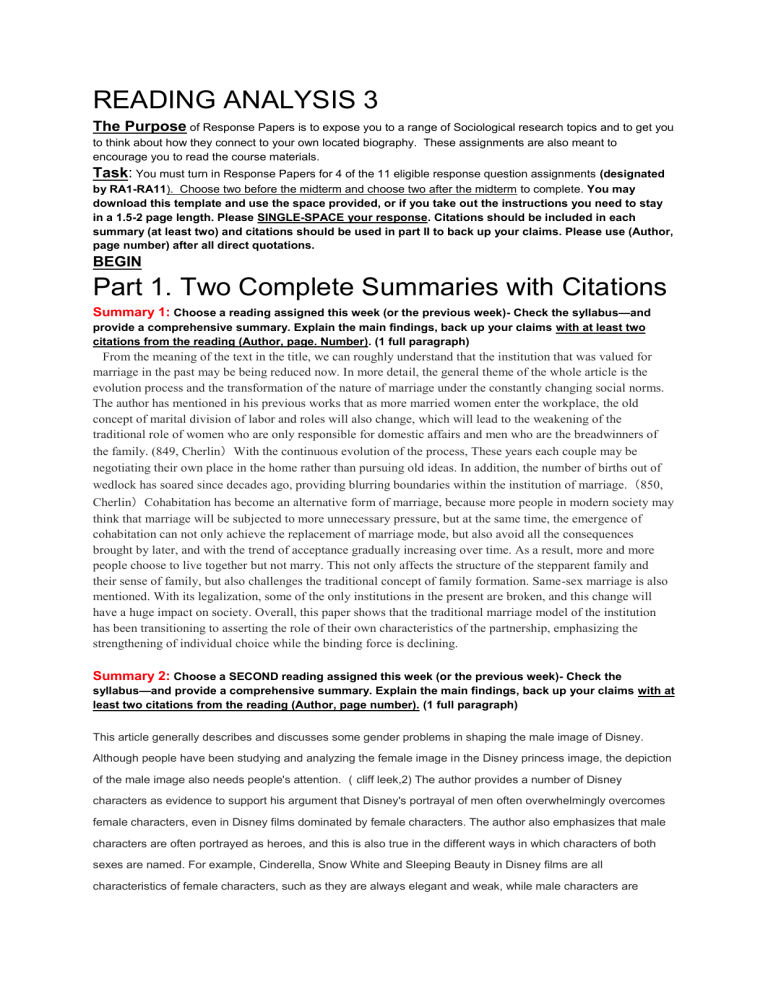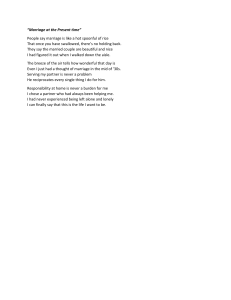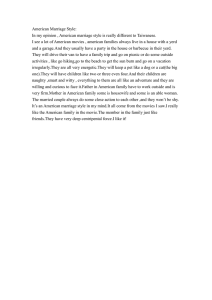
READING ANALYSIS 3 The Purpose of Response Papers is to expose you to a range of Sociological research topics and to get you to think about how they connect to your own located biography. These assignments are also meant to encourage you to read the course materials. Task: You must turn in Response Papers for 4 of the 11 eligible response question assignments (designated by RA1-RA11). Choose two before the midterm and choose two after the midterm to complete. You may download this template and use the space provided, or if you take out the instructions you need to stay in a 1.5-2 page length. Please SINGLE-SPACE your response. Citations should be included in each summary (at least two) and citations should be used in part II to back up your claims. Please use (Author, page number) after all direct quotations. BEGIN Part 1. Two Complete Summaries with Citations Summary 1: Choose a reading assigned this week (or the previous week)- Check the syllabus—and provide a comprehensive summary. Explain the main findings, back up your claims with at least two citations from the reading (Author, page. Number). (1 full paragraph) From the meaning of the text in the title, we can roughly understand that the institution that was valued for marriage in the past may be being reduced now. In more detail, the general theme of the whole article is the evolution process and the transformation of the nature of marriage under the constantly changing social norms. The author has mentioned in his previous works that as more married women enter the workplace, the old concept of marital division of labor and roles will also change, which will lead to the weakening of the traditional role of women who are only responsible for domestic affairs and men who are the breadwinners of the family. (849, Cherlin)With the continuous evolution of the process, These years each couple may be negotiating their own place in the home rather than pursuing old ideas. In addition, the number of births out of wedlock has soared since decades ago, providing blurring boundaries within the institution of marriage.(850, Cherlin)Cohabitation has become an alternative form of marriage, because more people in modern society may think that marriage will be subjected to more unnecessary pressure, but at the same time, the emergence of cohabitation can not only achieve the replacement of marriage mode, but also avoid all the consequences brought by later, and with the trend of acceptance gradually increasing over time. As a result, more and more people choose to live together but not marry. This not only affects the structure of the stepparent family and their sense of family, but also challenges the traditional concept of family formation. Same-sex marriage is also mentioned. With its legalization, some of the only institutions in the present are broken, and this change will have a huge impact on society. Overall, this paper shows that the traditional marriage model of the institution has been transitioning to asserting the role of their own characteristics of the partnership, emphasizing the strengthening of individual choice while the binding force is declining. Summary 2: Choose a SECOND reading assigned this week (or the previous week)- Check the syllabus—and provide a comprehensive summary. Explain the main findings, back up your claims with at least two citations from the reading (Author, page number). (1 full paragraph) This article generally describes and discusses some gender problems in shaping the male image of Disney. Although people have been studying and analyzing the female image in the Disney princess image, the depiction of the male image also needs people's attention. (cliff leek,2) The author provides a number of Disney characters as evidence to support his argument that Disney's portrayal of men often overwhelmingly overcomes female characters, even in Disney films dominated by female characters. The author also emphasizes that male characters are often portrayed as heroes, and this is also true in the different ways in which characters of both sexes are named. For example, Cinderella, Snow White and Sleeping Beauty in Disney films are all characteristics of female characters, such as they are always elegant and weak, while male characters are continually portrayed as heroes. And this allows boys who watch their films to reinforce their own sense of identity with their heroes, a strong gender bias that may contribute to the marginalization of female voices. (Cliff leek,2) In addition, readers commented on the marginalized impact of gender dynamics in the educational environment and movies on women. If the distribution of some roles and gender extremes are too strong and boys are dominant, the more likely it is to lead to gender inequality in society, society should examine the broader impact of gender on society from many aspects. Part 2: Written Analysis An analytical response to the question posed. (1 -2 paragraph) with references (Author, page number) to specific course material (be sure to cite accurately). An analytical response means that this is not merely your opinion, but it is an informed critique of the information posed. Reading Analysis 3: Family is often discussed outside sociological circles as commonsense, but the readings this week point out the way society has constructed the “normal” family and the social reasons for its existence. Discuss the historical functions of family described in your textbook and show how the concept of what a family IS, who can be a family, and what the purpose of a family has shifted over time due to economic, social, and political shifts. (CITE the textbook). Answer the question posed in your reading, “Deinstitutionalization of American Marriage:” why do people still get married? Be sure to address this question from a sociological perspective that alludes to history, structures, and power in society. Make sure to lay out the argument made in this article about and cite appropriately (Author, page number). The family has historically fulfilled various functional roles, adapting to diverse economic environments, cultural inheritance methods, and individual emotional needs. However, the definition and functions of the family are continually evolving alongside changes in economic, social, and political landscapes. Traditionally, a family was understood as a social unit typically consisting of a couple and their children, primarily focused on providing financial support, resource sharing, and satisfying the need for individual identity recognition in society(George Ritzer, 266). Nevertheless, societal developments have transformed the role and function of the family over time. Initially, the family was predominantly defined based on the traditional marriage system, emphasizing monogamy where men were the primary breadwinners and women mainly engaged in household duties. This traditional family model gradually shifted in the early 20th century due to various cultural trends, notably the emphasis on romantic love, culminating in the prevalent model of companionate marriage supported by genuine affection(Cherlin). The 1960s we have witnessed rising divorce rates, challenging the traditional perception of marriage, along with shifts in the labor force dynamics, including women entering the workforce(Georgia Rizer,275). These changes led to the emergence of individualized marriage, where marriage was no longer solely based on love but also accommodated practical considerations. However, these cultural and material shifts marked a significant transition in the meaning of marriage, evolving from a traditional institution to a partnership based on mutual love and equality, redefining gender roles within families. Subsequently, liberalized ideas regarding marriage emerged, with the acceptance of cohabiting couples and the legalization of same-sex marriage by the Supreme Court in 2015, reflecting substantial changes in the social model of marriage compared to the traditional system. In modern times, marriage and family are not only meant to meet society's expectations but also as a means of personal choice and self-actualization. While contemporary marriages offer financial and legal protections, individuals acknowledge the instability and risks associated with marriage in the modern era(George Ritzer, 272) Nonetheless, many value marriage and seek legal recognition as a couple and family, aiming to preserve this fundamental social unit despite societal changes. This underscores Americans' emphasis on social issues and their respect for historical and cultural systems, demonstrating their reluctance to relinquish certain traditional values(George Ritzer, 275).”


